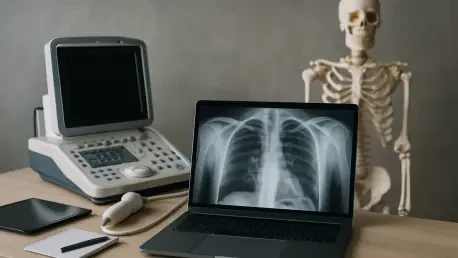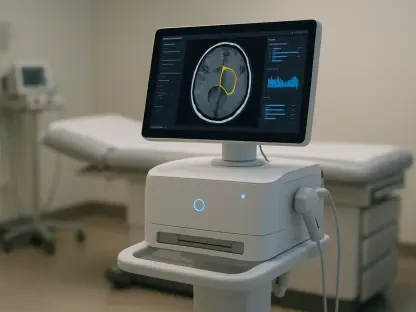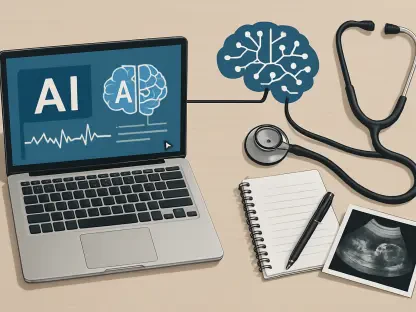In the ever-evolving landscape of healthcare, medical imaging stands as a cornerstone for diagnosing life-threatening conditions, yet the field faces a daunting challenge with a severe shortage of trained professionals. Sutter Health, a prominent healthcare system based in Northern California, is stepping up to address this crisis with an ambitious $5 million multi-year investment aimed at transforming the future of imaging. This initiative combines cutting-edge technology with comprehensive clinical training to not only enhance patient care but also build a sustainable workforce of radiologists and technologists. By partnering with industry leaders and focusing on education, Sutter Health is setting a new standard for how healthcare systems can tackle systemic challenges. The growing demand for diagnostic services, critical for detecting ailments like cancer and heart disease, underscores the urgency of such efforts. This bold move signals a commitment to innovation and excellence, ensuring that high-quality imaging remains accessible to all who need it.
Imaging as the Backbone of Modern Diagnostics
Medical imaging has earned its reputation as the “modern stethoscope,” serving as an essential tool in the diagnosis and treatment of countless conditions. It plays a pivotal role in identifying issues ranging from tumors to cardiovascular blockages, often before symptoms become apparent. Dr. Jason Wiesner, system chair of Sutter’s imaging service line, has highlighted that access to reliable, high-quality imaging is fundamental to delivering effective patient care. Without these advanced diagnostic capabilities, healthcare providers would struggle to make timely and accurate assessments, potentially delaying critical interventions. The significance of imaging extends beyond individual cases, shaping broader treatment strategies and improving overall health outcomes. Sutter Health’s recognition of this importance drives its mission to push the boundaries of what imaging can achieve, ensuring that technology and expertise keep pace with the rising needs of patients across diverse communities.
The impact of imaging on healthcare cannot be overstated, as it often serves as the first step in a patient’s journey toward recovery. It guides surgical decisions, informs therapeutic approaches, and monitors disease progression with precision. For conditions like lung disease or heart complications, early detection through imaging can mean the difference between life and death. Sutter Health’s focus on advancing this field reflects an understanding that enhancing diagnostic tools directly correlates with better survival rates and quality of life. Moreover, the integration of imaging into routine care has transformed how clinicians approach complex cases, making it an indispensable part of modern medicine. By prioritizing improvements in this area, Sutter Health aims to address gaps in access and accuracy, ensuring that every patient benefits from the latest advancements, regardless of location or background. This commitment lays the groundwork for a future where diagnostic excellence is the norm rather than the exception.
Addressing the Critical Shortage of Imaging Experts
A pressing issue facing the healthcare industry is the alarming scarcity of radiologists and imaging technologists, particularly in regions like Northern California. This shortage jeopardizes the ability to meet the growing demand for diagnostic services, creating bottlenecks in patient care. As Dr. Wiesner notes, radiologists often work behind the scenes, yet their expertise touches nearly every patient’s experience, from initial diagnosis to treatment planning. The lack of trained professionals can lead to longer wait times for scans and delayed results, which may hinder timely medical interventions. Sutter Health has identified this workforce gap as a critical barrier to delivering consistent, high-quality care, prompting a strategic focus on training and recruitment to bolster the number of skilled individuals in the field. Such efforts are essential to maintaining the integrity of diagnostic services amid rising healthcare needs.
Beyond the immediate impact on patient wait times, the shortage of imaging professionals has broader implications for healthcare equity and access. Rural and underserved areas often bear the brunt of this scarcity, where limited staff and resources exacerbate delays in diagnosis and treatment. Sutter Health’s initiative seeks to reverse this trend by investing in programs that cultivate talent and distribute expertise more evenly across communities. By addressing the root causes of the shortage, such as limited training opportunities and burnout among current practitioners, the organization aims to create a sustainable pipeline of professionals ready to meet future challenges. This proactive approach not only mitigates current deficiencies but also anticipates the increasing complexity of imaging needs as populations age and chronic conditions become more prevalent. Through targeted interventions, Sutter Health is paving the way for a more resilient healthcare workforce.
Revolutionizing Diagnostics with Advanced Technology
At the heart of Sutter Health’s strategy lies a powerful collaboration with GE HealthCare, a global leader in medical solutions, to integrate state-of-the-art technology into imaging practices. This partnership brings AI-powered diagnostic platforms to the forefront, significantly enhancing the accuracy and speed of detecting critical conditions like cancer and pulmonary diseases. Such tools analyze vast amounts of data in seconds, identifying subtle patterns that might escape the human eye, thus enabling earlier interventions that can save lives. The adoption of artificial intelligence and advanced analytics represents a seismic shift in how imaging contributes to precision medicine, moving beyond traditional methods to offer deeper insights into patient health. Sutter Health’s embrace of these innovations ensures that clinicians have access to the most sophisticated resources available, setting a benchmark for diagnostic excellence in the industry.
The benefits of technological advancements in imaging extend to streamlining workflows and reducing the burden on overworked staff. AI-driven systems can prioritize urgent cases by flagging abnormalities for immediate review, allowing radiologists to focus their expertise where it’s needed most. This efficiency is crucial in high-volume settings where time is often a limiting factor. Furthermore, the integration of such technologies fosters a culture of continuous improvement, as data from imaging results can be used to refine algorithms and enhance future diagnostics. Sutter Health’s commitment to staying at the cutting edge of these developments demonstrates a forward-thinking mindset, ensuring that patients receive care informed by the latest scientific breakthroughs. By leveraging these tools, the organization not only improves individual outcomes but also contributes to the broader evolution of healthcare delivery, positioning itself as a leader in the field.
Training the Next Generation of Radiologists
Education stands as a cornerstone of Sutter Health’s mission to address workforce shortages and elevate the standard of imaging care. A substantial portion of the $5 million investment is allocated to establishing a radiology residency program at Sutter Roseville Medical Center, as detailed by Dr. Khai Tran, medical director of Sutter Medical Group’s imaging service line. This program is designed to equip aspiring radiologists with both clinical proficiency and mastery of advanced technologies, preparing them to navigate the complexities of a rapidly evolving field. By fostering hands-on experience and exposure to cutting-edge tools, the initiative ensures that trainees are not just practitioners but innovators ready to lead. This focus on comprehensive training addresses immediate staffing needs while building a foundation for long-term advancements in diagnostic imaging across the region.
The residency program also emphasizes adaptability, recognizing that future radiologists must be prepared to work in diverse settings and with emerging technologies. Beyond technical skills, the curriculum prioritizes critical thinking and collaboration, essential traits for tackling complex medical challenges. Sutter Health’s vision, as articulated by Dr. Tran, is to create a training environment that mirrors real-world demands, ensuring graduates are well-versed in both patient care and system-wide coordination. This holistic approach aims to produce professionals who can bridge gaps in access, particularly in underserved areas where imaging expertise is scarce. By investing in education, Sutter Health not only addresses current shortages but also cultivates a legacy of excellence, ensuring that the next generation of imaging specialists is equipped to meet the evolving needs of healthcare with confidence and skill.
Strategic Partnerships Driving Sustainable Change
Collaboration forms the bedrock of Sutter Health’s transformative efforts in medical imaging, with its partnership with GE HealthCare exemplifying how industry alliances can address systemic challenges. This multi-year relationship combines technological innovation with clinical expertise, creating a synergy that enhances both patient care and professional training. The integration of advanced imaging solutions through this collaboration ensures that Sutter’s facilities are equipped with the best tools available, while also providing a platform for testing and refining new technologies. Meeting the rigorous standards of the Accreditation Council for Graduate Medical Education (ACGME) for the residency program further underscores the importance of coordinated planning across Sutter’s integrated system. Such partnerships highlight a model of shared responsibility, where each stakeholder contributes to a unified goal of improving healthcare delivery.
Beyond technology, the collaborative spirit extends to the operational framework of Sutter Health’s initiatives, involving faculty, physicians, and care teams in a cohesive effort. Establishing a residency program is no small feat, requiring meticulous attention to detail and alignment with national accreditation benchmarks. This process fosters a culture of accountability and excellence, ensuring that educational outcomes translate into tangible benefits for patients. The emphasis on strategic planning also allows Sutter Health to anticipate future hurdles, such as evolving regulatory requirements or shifts in healthcare demand, and adapt accordingly. By rooting its efforts in collaboration, the organization sets a precedent for how healthcare systems can work together with external partners to create sustainable, impactful change, ultimately strengthening the foundation of medical imaging for years to come.
Reflecting on a Visionary Path Forward
Looking back, Sutter Health’s bold steps to transform medical imaging through a $5 million investment and strategic partnerships marked a turning point in addressing critical workforce shortages and diagnostic challenges. The establishment of a radiology residency program at Sutter Roseville Medical Center stood as a testament to the power of education in building a skilled cadre of professionals. Meanwhile, the integration of AI and advanced technologies through collaboration with GE HealthCare redefined the precision and speed of patient care. Moving forward, the focus should shift to scaling these initiatives, ensuring that training programs reach more communities and that technological advancements remain accessible across diverse settings. Stakeholders must also prioritize ongoing evaluation of these efforts, adapting to emerging needs and innovations. By sustaining this momentum, Sutter Health can continue to lead the charge in shaping a future where high-quality imaging is a universal standard, closing care gaps for generations to come.









